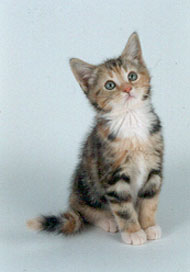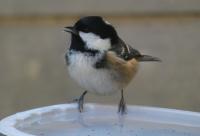- Home
- Special Offers
- New Products
- FAQs
- Customer Video Gallery
- Customer Photo Gallery
- Bird Facts
- Bird Food Blog
- Bird Information
- Feeding Advice
- Small Animal Information
- A to Z of Guinea Pigs
- A to Z of Hamsters
- A to Z of Rabbits
- Basic Care for Guinea Pigs
- Basic Care for Hamsters
- Basic Care for Rabbits
- Basic care for Chinchillas
- Basic care for Ferrets
- Basic care for Gerbils
- Basic care for Mice
- Basic care for Rats
- Buying a Healthy Small Animal
- Does your Reptile need a Licence
- Equipment for Ferrets
- Equipment for Hamsters
- Equipment for Mice
- Equipment for your Chinchilla
- Equipment for your Gerbil
- Equipment for your Guinea Pig
- Equipment for your Rabbit
- Keeping a House Rabbit
- Dog Information
- Cat Information
- Customer Information
- Bird Food
- Small Animals Food
- Pond Fish Food
- Dog Food
- Cat Food
- My Account
| Tweet |

|
Introducing New Kitten
The arrival of a new cat in the household is an event owners are understandably excited about, but an established feline resident may not be so enthusiastic! Kittens are great fun, but an adult cat may find their constant playing and pestering more than he can bear! Conflict between cats in the same household is a common reason for owners to seek behavioural advice. And when a newcomer pushes an established cat’s nose out of joint, the owner can feel extremely guilty. After all, the new kitten was supposed to be a playmate and enhance the resident cat’s life rather than cause him stress!
Twootz provides a great range of complete dry cat food specially formulated to provide all the nutrients necessary to maintain a nutritionally balanced diet that helps promote good health and vitality. Manufactured in the UK from quality ingredients this range has something for every cat.
Settling in
Although kindling a good relationship between your resident cat and the newcomer may be the obvious priority, remember that the kitten is entering a whole new world and needs help in adjusting to his new environment. If your kitten is settled and confident in his surroundings it will be beneficial when introducing him to your other cat. Entering a new environment is challenging and learning to accept the people, animals and inanimate objects that constitute a new home may not be plain sailing.
Household harmony
As well as being content in the company of the household’s humans, many owners want their kitten to be relaxed in the presence of their other cat. However, cats do not react well to being forced into situations and badly handled first introductions can have disastrous, and long-lasting effects, on household harmony!
Establishing friendships
It is essential when considering the introduction process to think in cat terms. A basic understanding of normal cat behaviour can go a long way towards ensuring successful integration. Although this approach takes considerably longer than the ‘put them in the same room and let them fight it out’ alternative, it definitely results in fewer casualties – both in a physical and a psychological sense. There are two important aspects of cat behaviour that hold the key to success: scent communication and the feline instinct to flee in the face of danger.
Understanding feline behaviour
Cats are often thought of as solitary creatures who are highly self-sufficient and somewhat dismissive of company, but we now know that they are capable of complex social relationships. However, this does not mean cats will readily accept another entering their territory! Accepting a newcomer is a far more gradual process than that: it’s worth remembering that wild cat groups expand from within through the arrival of kittens, rather than through the introduction of unrelated newcomers. Feline society is based on a matriarchal system, whereby related female cats (queens) share territory and assist one another in the rearing of their young, therefore there is limited innate capacity to welcome a stranger into their home environment.
What's that smell?
When strangers infiltrate an established feline group, the acceptance of the newcomer’s scent is the first stage in the integration process. If the scent is familiar and not associated with threat or danger, there is a far greater chance of acceptance. This is why it often helps to keep a new kitten in another room for the first few days. Here he is out of visual contact but is able to infiltrate scent signals into the family. Using communal bedding, toys and feeding bowls that are alternated between your resident cat and the newcomer on a daily basis can aid this process of infiltration. In some cases it helps to associate the newcomer’s smell with the owner’s scent, so using items of clothing (e.g. sweatshirts) as your cat’s bedding material can help the integration process.
The chase-flight cycle
When it comes to initial face-to-face introductions, protection is the name of the game. Cats have a strong sense of self-preservation so when danger looms their first response is to run. If a small kitten runs, however, an adult cat will invariably give chase! The usual result is a kitten trapped in an inaccessible nook or cranny, an adult cat frantically trying to get at it and a distraught owner yelling in disbelief that their pet could be so unkind to a defenceless kitten. All of this may be avoided by the use of an indoor pen.
Offering protection
An indoor pen is not a cage and should not be viewed as a feline prison cell. Instead it should be introduced as a sanctuary for your kitten from where he can watch the household in confidence.
A pen is an extremely useful tool when it comes to introductions, as its advantages are three-fold:
Obviously any pen must be of a suitable size and allow the kitten all-round visibility – after all, the last thing you want is for your resident cat to creep up from behind and launch an ambush! Kittens must not be left in these pens for excessive periods of time; short, frequent periods of introduction are usually the most beneficial.
In between these introductory sessions keep your cats in separate rooms so you can give each of them individual attention and affection, without risking a confrontation. If the resident cat is an outdoor individual, it may be worth using the time when he is out of the house to allow your kitten free run of the rooms, further distributing scent. It is also sensible to alternate putting your kitten and resident cat in the pen so your youngster learns to cope without the protection of bars.
Coming face-to-face
Once kitten and resident cat are reasonably relaxed in each other’s company, the time has come to begin a more positive introduction process. At this stage it is useful to have a positive signal that indicates the newcomer is not a threat, eg food. The act of feeding induces relaxation and a feeling of wellbeing, so it’s best to introduce the cats when both are hungry. Feed your kitten in his pen and the resident at the opposite end of the room. Gradually bring your resident cat’s bowl nearer to the pen, until both cats are perfectly happy to eat their food in close proximity.
Throughout the process, carefully observe all interactions between the two cats and watch out for signs of tension or anxiety. Once they seem happy in each other’s company with the physical barrier present, the time has come to dispense with the pen’s protection. It is essential the owner is present to supervise the first face-to-face encounter, but premature intervention and excessive reassurance for the younger cat may be counterproductive. Escape routes and safe havens for both cats must be provided – just in case things get too hot to handle! Remember that cats use vertical as well as horizontal space: providing shelves and other elevated resting places offers extra living space for the cats and gives them more opportunity to escape from one another!
No guarantees
Acquiring a new pet is exciting and, providing introductions are handled from a feline rather than a human point of view, the chances of successful integration of kitten and resident cat are fairly good. However, felines have distinct personalities and not all cats get on with others. Sometimes two individuals will never be compatible and rehoming the newcomer is the kindest option for all concerned. Thankfully this situation is rare: in most cases, multi-cat households work well for all concerned.
Important – please read
Although our experts always do their best to help, this service is not intended to be a replacement for a one-to-one consultation with your own vet. If you are worried about any aspect of your animal’s health, wellbeing or behaviour, always contact your own vet as soon as possible. Neither Twootz.com nor its contributors can be held responsible for the consequences of people acting solely on the information given on this website without seeking appropriate professional advice.

Twootz provides a great range of complete dry cat food specially formulated to provide all the nutrients necessary to maintain a nutritionally balanced diet that helps promote good health and vitality. Manufactured in the UK from quality ingredients this range has something for every cat.
Settling in
Although kindling a good relationship between your resident cat and the newcomer may be the obvious priority, remember that the kitten is entering a whole new world and needs help in adjusting to his new environment. If your kitten is settled and confident in his surroundings it will be beneficial when introducing him to your other cat. Entering a new environment is challenging and learning to accept the people, animals and inanimate objects that constitute a new home may not be plain sailing.
Household harmony
As well as being content in the company of the household’s humans, many owners want their kitten to be relaxed in the presence of their other cat. However, cats do not react well to being forced into situations and badly handled first introductions can have disastrous, and long-lasting effects, on household harmony!
Establishing friendships
It is essential when considering the introduction process to think in cat terms. A basic understanding of normal cat behaviour can go a long way towards ensuring successful integration. Although this approach takes considerably longer than the ‘put them in the same room and let them fight it out’ alternative, it definitely results in fewer casualties – both in a physical and a psychological sense. There are two important aspects of cat behaviour that hold the key to success: scent communication and the feline instinct to flee in the face of danger.
Understanding feline behaviour
Cats are often thought of as solitary creatures who are highly self-sufficient and somewhat dismissive of company, but we now know that they are capable of complex social relationships. However, this does not mean cats will readily accept another entering their territory! Accepting a newcomer is a far more gradual process than that: it’s worth remembering that wild cat groups expand from within through the arrival of kittens, rather than through the introduction of unrelated newcomers. Feline society is based on a matriarchal system, whereby related female cats (queens) share territory and assist one another in the rearing of their young, therefore there is limited innate capacity to welcome a stranger into their home environment.
What's that smell?
When strangers infiltrate an established feline group, the acceptance of the newcomer’s scent is the first stage in the integration process. If the scent is familiar and not associated with threat or danger, there is a far greater chance of acceptance. This is why it often helps to keep a new kitten in another room for the first few days. Here he is out of visual contact but is able to infiltrate scent signals into the family. Using communal bedding, toys and feeding bowls that are alternated between your resident cat and the newcomer on a daily basis can aid this process of infiltration. In some cases it helps to associate the newcomer’s smell with the owner’s scent, so using items of clothing (e.g. sweatshirts) as your cat’s bedding material can help the integration process.
The chase-flight cycle
When it comes to initial face-to-face introductions, protection is the name of the game. Cats have a strong sense of self-preservation so when danger looms their first response is to run. If a small kitten runs, however, an adult cat will invariably give chase! The usual result is a kitten trapped in an inaccessible nook or cranny, an adult cat frantically trying to get at it and a distraught owner yelling in disbelief that their pet could be so unkind to a defenceless kitten. All of this may be avoided by the use of an indoor pen.
Offering protection
An indoor pen is not a cage and should not be viewed as a feline prison cell. Instead it should be introduced as a sanctuary for your kitten from where he can watch the household in confidence.
A pen is an extremely useful tool when it comes to introductions, as its advantages are three-fold:
- It blocks the kitten’s escape route and therefore limits the triggering of a chase response from the resident cat
- It prevents the resident cat from intimidating the newcomer or from giving chase
- It gives both felines the chance to see and smell each other without any threat of forced social interaction or fear of physical attack
Obviously any pen must be of a suitable size and allow the kitten all-round visibility – after all, the last thing you want is for your resident cat to creep up from behind and launch an ambush! Kittens must not be left in these pens for excessive periods of time; short, frequent periods of introduction are usually the most beneficial.
In between these introductory sessions keep your cats in separate rooms so you can give each of them individual attention and affection, without risking a confrontation. If the resident cat is an outdoor individual, it may be worth using the time when he is out of the house to allow your kitten free run of the rooms, further distributing scent. It is also sensible to alternate putting your kitten and resident cat in the pen so your youngster learns to cope without the protection of bars.
Coming face-to-face
Once kitten and resident cat are reasonably relaxed in each other’s company, the time has come to begin a more positive introduction process. At this stage it is useful to have a positive signal that indicates the newcomer is not a threat, eg food. The act of feeding induces relaxation and a feeling of wellbeing, so it’s best to introduce the cats when both are hungry. Feed your kitten in his pen and the resident at the opposite end of the room. Gradually bring your resident cat’s bowl nearer to the pen, until both cats are perfectly happy to eat their food in close proximity.
Throughout the process, carefully observe all interactions between the two cats and watch out for signs of tension or anxiety. Once they seem happy in each other’s company with the physical barrier present, the time has come to dispense with the pen’s protection. It is essential the owner is present to supervise the first face-to-face encounter, but premature intervention and excessive reassurance for the younger cat may be counterproductive. Escape routes and safe havens for both cats must be provided – just in case things get too hot to handle! Remember that cats use vertical as well as horizontal space: providing shelves and other elevated resting places offers extra living space for the cats and gives them more opportunity to escape from one another!
No guarantees
Acquiring a new pet is exciting and, providing introductions are handled from a feline rather than a human point of view, the chances of successful integration of kitten and resident cat are fairly good. However, felines have distinct personalities and not all cats get on with others. Sometimes two individuals will never be compatible and rehoming the newcomer is the kindest option for all concerned. Thankfully this situation is rare: in most cases, multi-cat households work well for all concerned.
Important – please read
Although our experts always do their best to help, this service is not intended to be a replacement for a one-to-one consultation with your own vet. If you are worried about any aspect of your animal’s health, wellbeing or behaviour, always contact your own vet as soon as possible. Neither Twootz.com nor its contributors can be held responsible for the consequences of people acting solely on the information given on this website without seeking appropriate professional advice.













